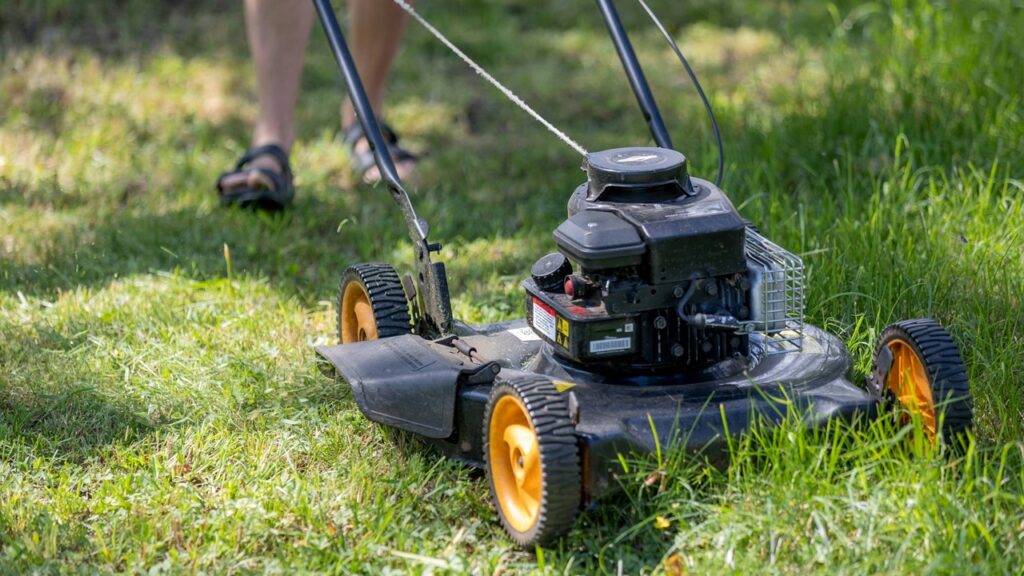
Charging a lawn mower battery at 2 amps usually takes 6 to 24 hours. It depends on the battery size, how much it has been drained, and the charger. A typical 12-volt battery may need 6 to 9 hours for a full charge. If it’s only partially drained, it’ll take less time.
This article explains how to calculate the charging time, what factors affect it, and how to keep your battery healthy. It also covers safety tips and how to tell when your battery is fully charged.
How Long Does It Take to Charge a Lawn Mower Battery at 2 Amp?
Charging a lawn mower battery at 2 amps usually takes between 6 and 24 hours, depending on the battery’s size, condition, and how much it was drained. For example, a 12-volt lawn mower battery with a capacity of 28 to 35 amp-hours (Ah) will take about 6 to 9 hours to charge fully if it’s completely drained. If the battery is only half-empty, the time will be shorter. But if the battery is older, deeply discharged, or has been sitting unused for a long time, charging could take 12 to 24 hours. Charging slowly at 2 amps helps protect the battery’s health by preventing overheating and overcharging.
Typical Charging Times for 2-Amp Chargers
Here’s a simple breakdown to help you figure out how long it might take:
- 6 to 9 Hours: For a standard 12-volt, 28-35Ah lawn mower battery that’s completely drained.
- 9 to 12 Hours: For larger batteries (like a 40Ah or 50Ah) or when the battery has been left unused for months.
- 12 to 24 Hours: For batteries that are in poor condition, very old, or heavily sulfated.
If your battery is only partially discharged, the charging time will be much shorter. A 12-volt lawn mower battery that’s 50% drained might only take 3 to 5 hours to charge at 2 amps.
Using a 2-amp charger is ideal for smaller batteries like lawn mower batteries because slow charging helps prevent overheating, which can cause a battery to lose its ability to hold a charge. This slower approach is gentle on the battery and extends its overall lifespan.
Why Charging Time Varies
The charging time isn’t the same for every battery because a few important factors come into play:
- Battery Size (Amp-Hour Rating): The size of your lawn mower battery, measured in amp-hours (Ah), directly affects how long it will take to charge. A 28Ah battery will charge faster than a 50Ah battery at the same 2-amp setting. Think of it like filling up a water tank—bigger tanks take longer to fill at the same flow rate.
- Battery Condition: A battery that has been sitting unused, is deeply discharged, or has internal problems like sulfation will take longer to charge. Sometimes, older batteries have damaged cells that won’t hold a charge well, which can slow down charging or stop it altogether.
- Charger Efficiency: Not every charger runs perfectly. Some may not deliver a constant 2 amps, especially if the charger has automatic features like a trickle charge mode. When the battery gets close to full, the charger may automatically reduce the amperage to avoid overcharging. While this is helpful for battery safety, it adds time to the charging process.
- Trickle Charging and Smart Chargers: Many newer chargers switch to a trickle charge when the battery reaches about 80–90% full. This slower rate prevents overcharging but extends the charging time by a few hours. A smart charger for lawn mower batteries usually shows an indicator when charging is complete, so you know when to unplug it.
By understanding these points, you can figure out the most accurate charging time for your lawn mower battery. This helps avoid overcharging, keeps your battery healthy, and makes sure your mower is ready to go when you need it.
How to Calculate Charging Time for Your Lawn Mower Battery
A quick answer? Divide the battery’s capacity (in amp-hours) by the charger’s amps. For example, a 30Ah battery divided by a 2-amp charger gives you around 15 hours. This estimate works best for a fully drained battery. If your battery is only half-empty, it’ll take half that time. Keep in mind—this is just a ballpark number. Real-life stuff, like an old battery or a charger that’s not running at full strength, can change the timing.
The Simple Formula
Here’s a quick rule of thumb that works:
- Battery Capacity (Ah) ÷ Charger Amps = Approximate Charge Time
- For a 30Ah battery on a 2-amp charger:
- 30 ÷ 2 = 15 hours
- For a 20Ah battery on the same charger:
- 20 ÷ 2 = 10 hours
This is a simple math shortcut. It’s not perfect, but it gives you a good sense of how long you might be waiting.
Quick Charging Time Estimates for Lawn Mower Batteries at 2 Amps:
| Battery Size (Ah) | Estimated Charging Time (2 Amps) |
| 20Ah | 10 hours |
| 28Ah | 14 hours |
| 35Ah | 17.5 hours |
| 40Ah | 20 hours |
| 50Ah | 25 hours |
Real-World Factors Affecting This Formula
Real life is messy, and a few things can throw off this simple math:
- Charger Efficiency: Not all chargers deliver a steady 2 amps. Some slow down as the battery gets close to full, which adds hours to the process.
- Battery Condition: A new battery charges faster than an old one. If your battery has been sitting around for a while or is sulfated, it might take way longer—or not charge fully at all.
- Partial Charge: If your battery isn’t fully drained, it won’t take as long to top up. A battery at 50% charge will usually need half the time.
- Trickle Charge Mode: Many modern chargers switch to a lower amp mode when the battery is nearly full. It’s like filling a glass of water slowly at the end so it doesn’t spill.
The key takeaway? The formula is a starting point, but always expect a little wiggle room.
Signs Your Lawn Mower Battery is Fully Charged
Wondering if your battery is ready to roll? A fully charged 12-volt lawn mower battery should show around 12.6 to 12.8 volts when you check it with a multimeter. If your charger has a display or an indicator light, it’ll usually switch to green or show “full” when the job’s done. For most chargers, that’s your signal to unplug.
Fully Charged Voltage Levels for Lawn Mower Batteries:
| Battery Type | Fully Charged Voltage |
| 12-Volt Lead-Acid | 12.6 – 12.8 Volts |
| 12-Volt AGM | 12.8 – 13.0 Volts |
| 6-Volt Lead-Acid | 6.3 – 6.4 Volts |
Visual and Indicator Cues
Here’s what you can look for:
- Green Light or Full Symbol: Most chargers give you a simple “all done” sign when charging is complete.
- Voltage Reading: Use a multimeter to check the battery. For a 12-volt lawn mower battery, anything around 12.6 to 12.8 volts is fully charged.
- No Change in Voltage for Hours: If your voltage stays the same over a few hours, the battery is as full as it’s going to get.
Can You Overcharge a Lawn Mower Battery at 2 Amps?
Yes, you can. Even at 2 amps, leaving a charger connected for too long, especially an old-school, manual one, can hurt the battery. It might overheat, lose capacity, or leak acid. If you’re using a smart charger, it usually switches to trickle mode automatically, which helps prevent damage. But if you’ve got a basic charger without auto-shutoff, it’s on you to unplug it once the battery is full.
Safety Tips for Charging a Lawn Mower Battery at 2 Amp
Charging a lawn mower battery isn’t complicated, but there are a few things to keep in mind so you don’t end up with sparks, acid leaks, or a ruined battery.
Before You Begin
- Safety First: Gloves and safety glasses protect your hands and eyes.
- Check Your Space: Make sure you’re in a dry, well-ventilated spot, away from gas cans or anything flammable.
- Inspect the Battery: Look for cracks, leaks, or corrosion before you charge. If the battery looks damaged, it’s safer to replace it.
While Charging
- Connect Properly: Red clamp to positive (+), black clamp to negative (-). Get this wrong, and you could damage both the battery and the charger.
- Stay Nearby: Don’t leave a charging battery running while you’re out for the day. Check in on it once in a while.
- Let It Breathe: Keep the area around the charger and battery clear. Batteries can give off small amounts of gas, so airflow matters.
After Charging
- Turn It Off Safely: Unplug the charger first, then remove the clamps. Start with the negative clamp, then the positive.
- Store the Battery Right: If you’re not putting the battery back in the mower right away, keep it in a cool, dry place—away from freezing temps or direct sunlight.
Maintaining Your Lawn Mower Battery for Longer Life
To keep your lawn mower battery healthy, charge it regularly, clean the terminals, and store it in a cool, dry place when not in use. Batteries lose charge over time, especially in cold weather, so it’s a good habit to check your voltage every few weeks during the mowing season and monthly in the off-season. Proper care helps your lawn mower battery last longer and avoid unexpected failures.
Here’s how to get the most life out of your lawn mower battery:
- Charge it regularly: Don’t wait until the battery is dead. Topping it off when the voltage drops below 12.4 volts keeps it strong.
- Keep terminals clean: Corrosion builds up and can slow down charging or stop it altogether. A wire brush and a little petroleum jelly go a long way.
- Store it properly: When the season’s over, disconnect the battery and store it in a dry spot away from extreme temperatures.
- Use a smart charger or maintainer: These chargers prevent overcharging by switching to a low trickle mode when the battery is full.
- Inspect it regularly: Check for swelling, cracks, or leaks. If you see damage, it’s better to replace the battery than risk a breakdown later.
With these simple steps, you’ll stretch your battery’s life and avoid the headache of a dead mower when the grass is calling.
Final Thoughts
Charging a lawn mower battery at 2 amps is a safe, slow way to get the job done without damaging the battery. For most 12-volt lawn mower batteries in the 28Ah to 35Ah range, expect it to take around 6 to 9 hours for a full charge if the battery is completely empty. Larger batteries, or those that are older or deeply drained, may need 12 hours or more to reach full capacity.
Using a 2-amp charger helps prevent overheating and extends your battery’s life, especially when combined with good habits like keeping terminals clean and storing the battery properly in the off-season. Always check your voltage or charger indicator to know when your battery is ready to go, and don’t leave it charging for days unless you’re using a smart charger.
Taking care of your lawn mower battery means fewer problems and more time mowing when it matters. With a little attention and the right charging routine, your battery can last for years.
Related FAQs
Can I Use a Higher Amp Charger for Faster Charging?
Yes, but it’s riskier. Higher amp chargers work faster but can overheat and damage small lawn mower batteries.
What Happens If I Leave My Battery on a 2-Amp Charger Overnight?
If your charger has auto shut-off, it’s fine. If not, you risk overcharging, which can harm the battery.
Do All Lawn Mower Batteries Need to Be Charged at 2 Amps?
No, but 2 amps is a safe choice for most 12-volt lawn mower batteries. Always check your battery label.
Is It Safe to Charge My Lawn Mower Battery Indoors?
Yes, if the space is well-ventilated. Avoid charging near flames or in tight, unventilated areas.
How Can I Check My Battery’s Capacity Before Charging?
Look at the battery label for the amp-hour rating. Or, check the voltage with a multimeter, 12.6 to 12.8 volts means fully charged.

At our core, we’re a group of passionate yard, garden and mown enthusiasts. We dive deep into the world of backyard of your home. We try to provide as much value to the readers with our information and how to blog articles as possible along with proper information-based reviews as well.




